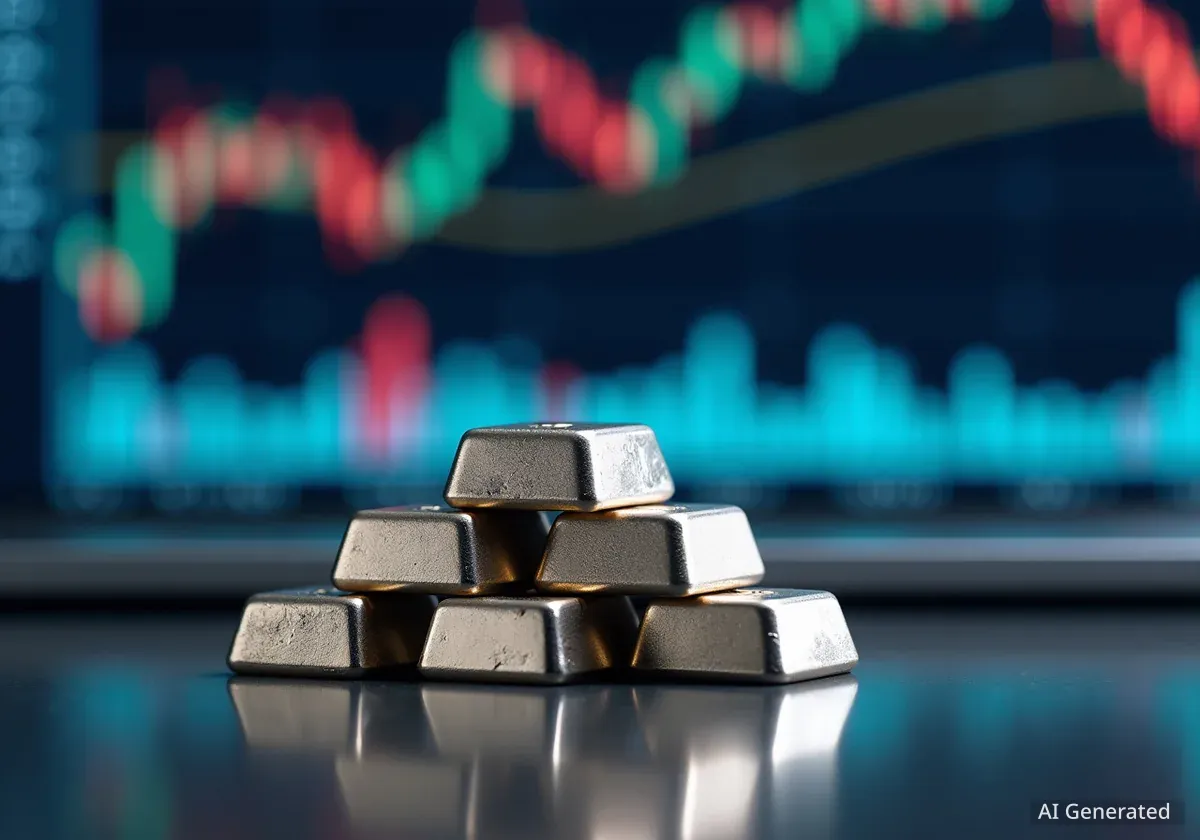Silver prices surged to their highest levels in decades on Monday, driven by a significant rally in gold and a major liquidity squeeze within the London market. This sharp increase highlights growing investor interest in precious metals.
Key Takeaways
- Silver futures in New York climbed 5.2% to $49.69 a troy ounce.
- Spot silver prices exceeded $50 an ounce, rising 2.3%.
- The rally is linked to gold's historic performance and a London market liquidity squeeze.
- Increased demand for safe-haven assets is a contributing factor.
Silver Futures and Spot Prices Climb
On Monday morning, European trading saw significant movement in the silver market. Silver futures in New York experienced a notable increase, climbing by 5.2%. This pushed the price to $49.69 per troy ounce. This level represents a multi-decade high for the commodity.
Simultaneously, spot silver prices also showed strong gains. They surpassed the $50 per ounce mark, an event not seen in many years. Spot prices recorded a 2.3% rise, reaching $51.44 an ounce. These figures underscore the robust demand for silver in current market conditions.
Silver's Value
Historically, silver has often been referred to as 'poor man's gold' due to its lower price point, but its industrial uses in electronics, solar panels, and medical applications make its demand dynamic and distinct from gold.
Factors Driving the Price Surge
The primary catalyst for silver's sharp ascent is closely tied to the performance of gold. Gold has been experiencing its own historic rally, attracting significant investor capital. As gold's price increases, investors often look to silver as an alternative precious metal, sometimes referred to as 'poor man's gold,' which can offer similar safe-haven benefits at a lower entry point.
Another critical factor cited is a massive liquidity squeeze in the London market. This situation means there is a shortage of readily available physical silver or the means to settle transactions efficiently, which can drive up prices as buyers compete for limited supply. Such squeezes can amplify price movements, especially in commodity markets.
"The interplay between gold's strong performance and the unique supply-demand dynamics in key trading hubs like London is creating a powerful upward force for silver prices," noted a market analyst familiar with precious metals trading.
Understanding Market Liquidity
Market liquidity refers to how easily an asset can be converted into cash without affecting its price. In the context of commodities like silver, a liquidity squeeze means that there is a sudden, unexpected shortage of either the physical metal or the financial instruments needed to trade it. This can make it difficult for large institutional buyers to acquire the quantities they need without significantly bidding up the price.
Such events are not uncommon in commodity markets, but when combined with strong underlying demand for precious metals, their impact can be profound. The London market plays a crucial role in global silver trading, making any disruptions there highly influential.
Historical Context of Silver Peaks
While specific price points can fluctuate, silver has seen significant rallies in the past, often during periods of economic uncertainty or high inflation. Reaching or surpassing the $50 mark is a rare occurrence, typically indicative of strong market forces at play.
Investor Sentiment and Future Outlook
The current economic climate, marked by ongoing geopolitical tensions and inflationary pressures, has increased investor appetite for safe-haven assets. Both gold and silver are traditionally seen as stores of value during times of uncertainty, helping to preserve wealth against inflation and currency devaluation.
Analysts are now closely watching whether silver can sustain these elevated levels. The sustainability will depend on continued gold strength, the resolution of the London market's liquidity issues, and broader macroeconomic trends. Industrial demand for silver, which accounts for a significant portion of its usage, will also play a role in its long-term price trajectory.
- Industrial Demand: Silver is vital for electronics, solar energy, and medical devices.
- Investment Demand: Investors buy silver as a hedge against inflation and economic instability.
- Supply Dynamics: Mining output and recycling rates influence overall supply.
The recent price movements underscore the volatility and potential for significant gains in the precious metals sector. Investors are encouraged to consider the various factors influencing these markets when making decisions.





